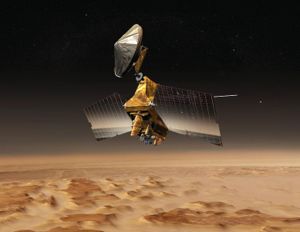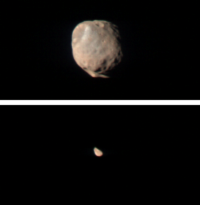Mars Reconnaissance Orbiter
Launched on August 12, 2005 by an Atlas V rocket from Cape Canaveral Air Force Station, the Mars Reconnaissance Orbiter (MRO) carrying HiRISE and other instruments arrived at Mars on March 10, 2006. However, it did not begin its main picture taking until November 2006. A long The NASA mission began taking data in November 2006 after completion of a long aerobreaking maneuver in the upper Mars atmosphere to place it in the desired orbit. The orbit has an inclination of 93 degrees, which means it orbits north and south in a polar orbit, as the planet turns beneath it.[1] As a result of the characteristics of its orbit, HiRISE takes pictures at about 3 p.m. local time. This time frame produces few shadows, but does avoid morning mist. To arrange for communications support during the arrival of the InSight Mars lander mission, the orbit was slightly modified on September 28, 2016 by a 75 second engine burn. [2] [3]
Science goals and instrumentation
The MRO is intended to contribute to the four main areas outlined by NASA's Mars Exploration Program.
- Determine whether life ever arose on Mars
- Characterize the climate of Mars
- Characterize the geology of Mars
- Prepare for human exploration
The orbiting satellite is making this possible through the use of some of the most advanced optics available to modern spacecraft. The High Resolution Imaging Science Experiment (HiRISE) is investigating the geology of Mars to identify deposits that are a result of climatic and geologic processes. This new, high resolution approach will aid future landing sites for robotic and manned missions to the Red Planet. Current resolution capabilities can produce images of features of less than 1 meter. For high priority targets, a stereo method can be applied so features of 25 cm can be imaged.[4]
The Compact Reconnaissance Imaging Spectrometer for Mars (CRISM) is primarily used to detect any evidence for past and present traces of water through the analysis of minerals and geology. In particular is the objective to help locate Martian resources that could provide local support for eventual human exploration and colonization of Mars.[5] The most important of these is water.
In an effort to characterize the 4 dimensional dynamics of the Mars atmosphere (3 spatial dimensions and time), the Mars Climate Sounder (MCS) is used to acquire profiles of the lower 50 miles of the atmosphere, including clouds, dust, pressure and temperature.[6]
References
- ↑ Lyons, Daniel T. (August 5–8, 2002). "MARS RECONNAISSANCE ORBITER: AEROBRAKING REFERENCE TRAJECTORY" (PDF). AIAA/AAS Astrodynamics Specialist Conference and Exhibit. Archived from the original (PDF) on October 18, 2011. Retrieved March 9, 2012.
- ↑ NASA Mars Orbiter Preparing for Mars Lander's 2016 Arrival
- ↑ Mars orbiter prepares for next year's InSight lander arrival. July 29, 2015.
- ↑ HiRISE homepage
- ↑ CRISM homepage
- ↑ MCS homepage








